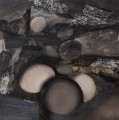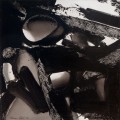Pranas Lapė
Biography
Painting became the passion of Pranas Lapė at the gymnasium already. He was influenced by the teacher Vytautas Kairiūkštis much. After starting with figure paintings, P. Lapė turned towards abstract expressionism later. The artist illustrated books, created wall paintings, scenography, engravings. Pranas Lape was born on January 11, 1921 in Klaipeda. From 1941 to 1943 he studied at Kaunas Institute of Applied Arts. In 1944, ahead of the threatening Soviet Russian Occupation, he left Lithuania and moved to the West. Through Germany, Finland and Norway, he reached Sweden. In 1945–1946 he continued his studies at the private Anders Beckman School in Stockholm. From 1946 to 1949 Pranas Lape taught life drawing classes at the same school. Christmas 1949 he emigrated to the United States of America and settled in New York City.
From 1950 to 1956 he worked as a free-lance artist, mostly designing and illustrating books for the largest publishers in New York: Doubleday, Scribners, Random House, Grosset & Dunlap, etc. After several years working in the commercial art field, he realized that commercial work was a negative influence on his own art work. Meanwhile, he was offered a position to organize and lead the art program at a private high school. Consequently, in 1957, Pranas Lape moved to Rowayton, Connecticut where he took the position as Art Director at the Thomas School. In 1972 Pranas Lape signed a five-year contract to design a similar program for the Belmont Hill School in Belmont, Massachusetts. In 1978 Pranas Lape left educational work and moved to Chamberlain, Maine where he devoted his efforts exclusively to painting. Painting has always been of great interest in his life. He was especially inspired by his early art teacher, Vytautas Kairiukstis, who himself greatly admired the painter Pierre Bonnard. Later in Sweden, while working on murals, the beauty and the act of painting deepened Lape’s interest and commitment to the art of painting.
As a book illustrator Pranas Lape designed over 300 book covers for American and Lithuanian publishers. He has illustrated The Forest of “Anykščiai” by Antanas Baranauskas (1961), “Ballades” by Maironis (1966), “The Land of Foster-Children” by Algimantas Mackus (1984), “On the Way to the Promised Land” by Antanas Gustaitis (1986), etc. He also worked on set designs for indoor and outdoor theatrical performances. While residing in Stockholm he designed murals for The World Sport Exhibition, Stockholm (1948) and for The World Congress for Nurses, Stockholm (1949). Lape began to exhibit his work in 1953 in New York. Since then he has participated in numerous group exhibitions with both Lithuanian and American artists. He has had only five solo exhibitions: 1965 Long Island, 1969 Chicago, 1980 New Canaan, 1981 Brooklyn and 1985 Boston.
Pranas Lape kept close contact with Lithuania during his exile. In 1964, he visited the occupied Lithuania, for the first time. When Lithuania restored its independence, after numerous previous visits, he returned permanently to his native land.
Style
Painting became the passion of Pranas Lapė at the gymnasium already. He was influenced by the teacher Vytautas Kairiūkštis much. After starting with figure paintings, P. Lapė turned towards abstract expressionism later. The artist illustrated books, created wall paintings, scenography, engravings.
2012 © VšĮ „Lietuvos išeivijos dailės fondas“, A.Tumėno g. 4, VilniusE: info@iseivijosdaile.lt P: +370 5 2644741 F: +370 5 2644742








